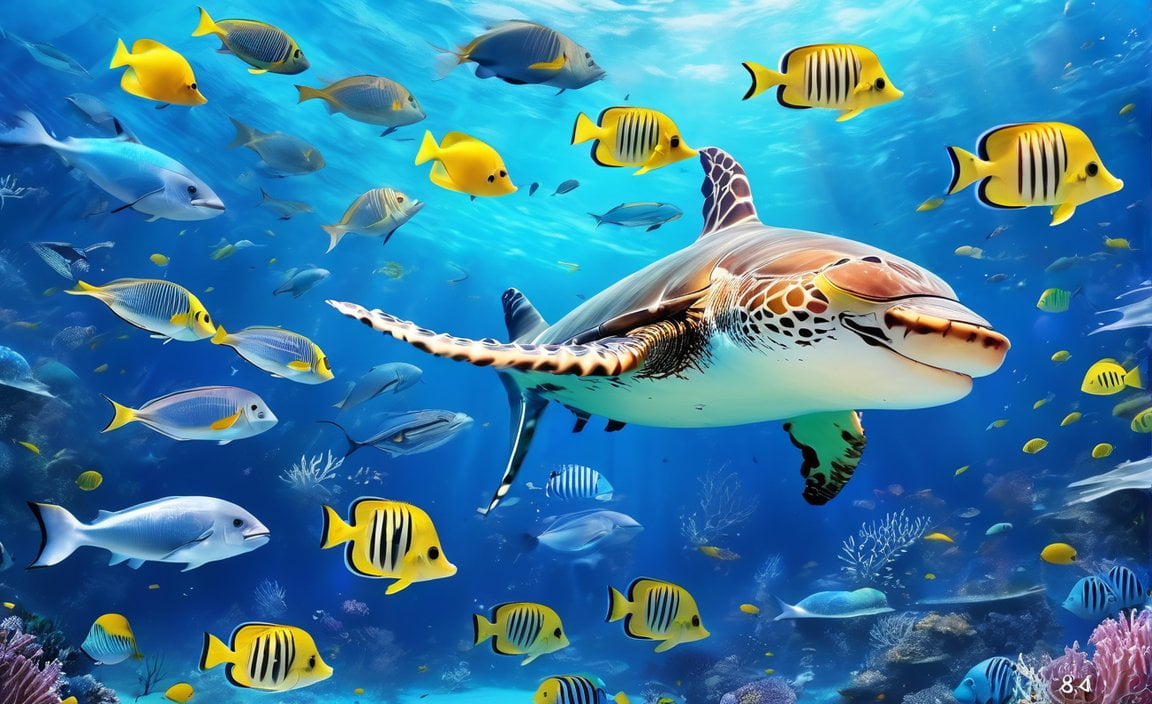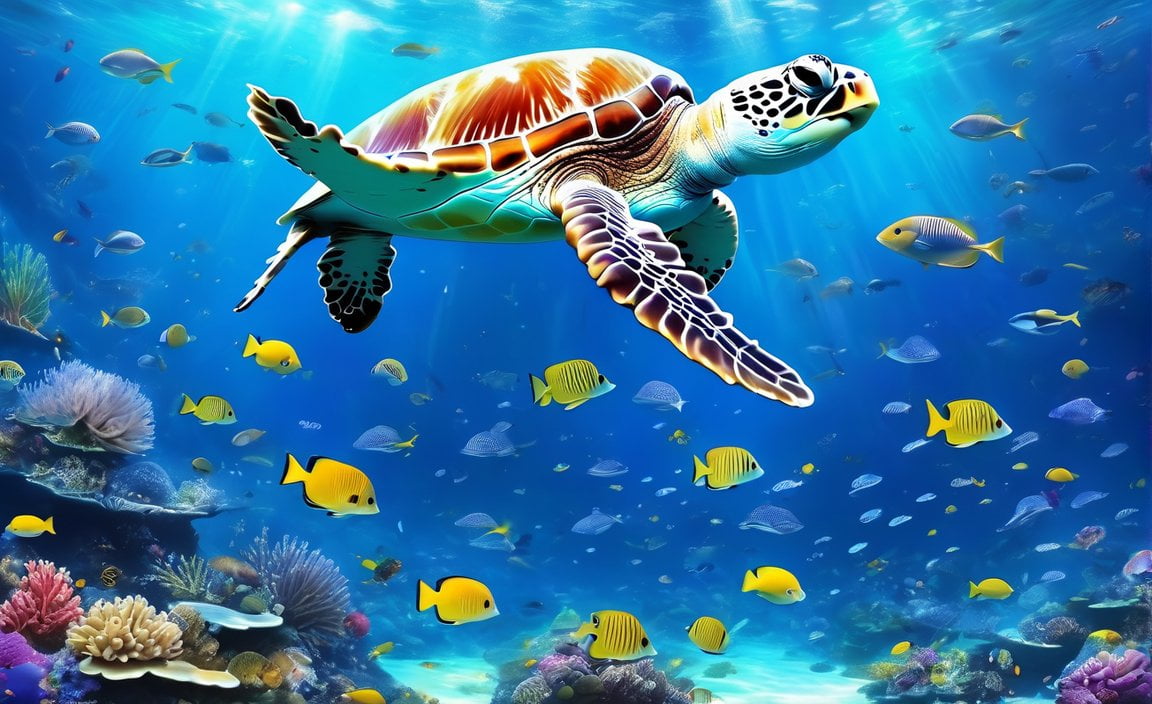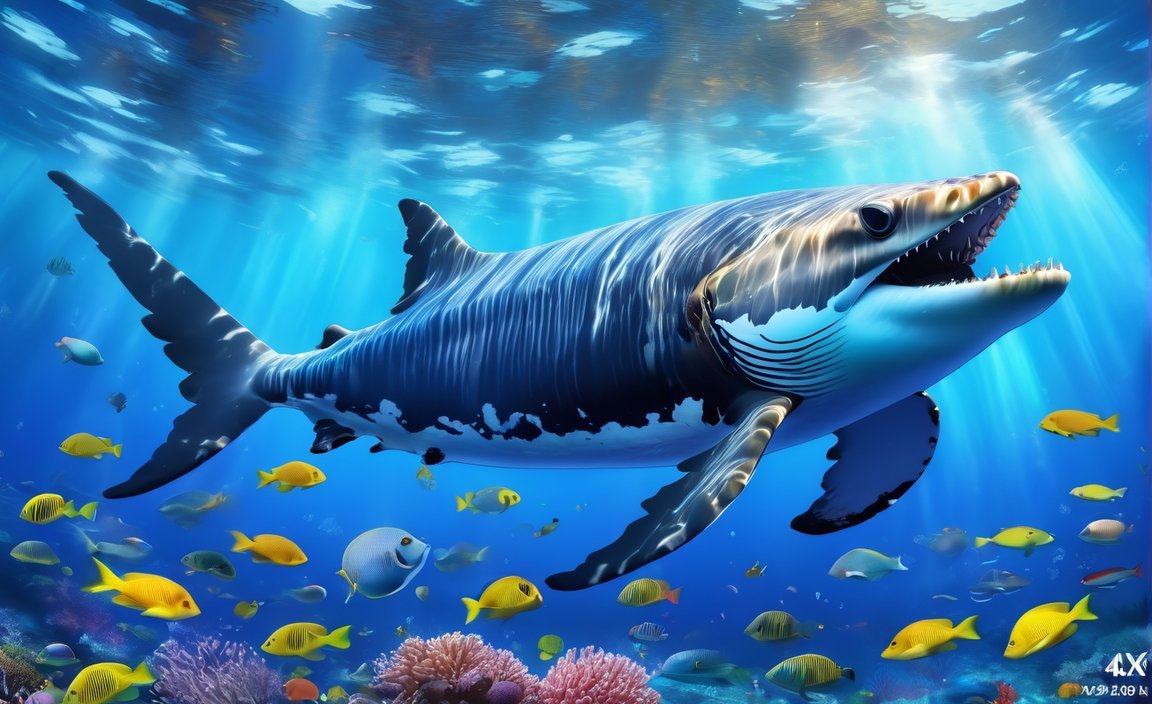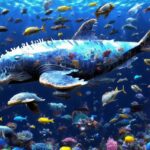Get ready to be amazed as we dive into the depths of the ocean and uncover mind-blowing facts about marine animals. From the mysterious adaptations of deep-sea creatures to the incredible intelligence of dolphins, this article will take you on a journey through the wonders of the underwater world. Join us as we explore the fascinating lives and astonishing abilities of these remarkable creatures that inhabit our oceans.
Key Takeaways:
- Jellyfish have been around for more than 650 million years, pre-dating dinosaurs and sharks.
- Electric Eels can produce enough electricity to light up to 10 bulbs.
- Dolphins sleep with half of their brain and one eye open to watch for predators and threats.
- The first animals traced back 40 million years ago were Ediacara biota, measuring only a few centimeters in length.
- Coral reefs contain approximately one-fourth of the world’s marine species.
- Male sea horses get pregnant and give birth.
- Stonefish are considered one of the most dangerous sea animals due to their venomous spines.
Amazing Facts About Marine Animals

Jellyfish: Ancient Survivors
Jellyfish have an incredible history, predating dinosaurs and even sharks. These fascinating creatures have been around for more than 650 million years. Can you imagine? They’ve been gracefully swimming through the oceans long before the existence of many other animals that we’re familiar with today. Their long-standing presence is a testament to their resilience and adaptability in marine environments.
Electric Eels: Nature’s Living Batteries
Did you know that electric eels possess the stunning ability to produce electricity? These remarkable creatures can generate enough power to light up to 10 bulbs! They use electric currents not only for self-defense but also to navigate their surroundings and locate prey. It’s like having a living battery swimming through the depths of the water. The sheer power they possess is truly awe-inspiring!
Dolphins: Sleep and Vigilance Combined
One of the most fascinating facts about dolphins is their unique sleeping pattern. Unlike humans who drift off into a deep slumber, dolphins have evolved a clever way to remain vigilant even while resting. They sleep with half of their brain and one eye open, allowing them to keep a close watch for predators and potential threats. It’s like they have a built-in security system, ensuring their safety while still getting some shuteye. Now that’s smart!
The Ancient Ediacara Biota: The First of Their Kind
If we take a trip back in time, we’ll discover the ancient Ediacara biota. These peculiar organisms existed around 40 million years ago and were some of the earliest animal life on Earth. Despite being tiny, only measuring a few centimeters in length, they played a significant role in shaping the marine ecosystems of their time. Their fossilized remains provide valuable insights into the early stages of evolutionary history.
Coral Reefs: Biodiversity Hotspots
Coral reefs are not only breathtakingly beautiful but also teeming with life. These vibrant underwater ecosystems harbor approximately one-fourth of the world’s marine species. From colorful fish to intricate coral formations, coral reefs are biodiversity hotspots, supporting an astonishing array of underwater life. They are like bustling cities, with each resident playing a crucial role in maintaining the delicate balance of the reef community.
Male Sea Horses: Nature’s True Fathers
In the world of marine animals, it’s the males that take on the responsibility of pregnancy and birth. Sea horses, in particular, are captivating creatures in this regard. The male sea horse carries the eggs in a special pouch until they are ready to hatch. Once the time comes, the male sea horse gives birth to dozens or even hundreds of tiny sea horses. It’s a remarkable example of role reversal in the animal kingdom and showcases the incredible diversity of reproductive strategies.
Stonefish: A Venomous Master of Camouflage
While the oceans are home to an abundance of mesmerizing creatures, some of them pose serious dangers. Among them is the stonefish, considered one of the most venomous sea animals. With its venomous spines and remarkable ability to camouflage itself against rocks and coral, the stonefish is a stealthy predator. Stepping on one of these masters of disguise can result in excruciating pain and even death. It serves as a reminder of the beauty and danger that coexist in the underwater realm.
By delving into the mesmerizing world of marine animals, we come across a multitude of mind-blowing facts. From ancient survivors to nature’s living batteries, these remarkable creatures continue to awe us with their incredible adaptations. Whether it’s dolphins’ sleep vigilance or the role reversal in sea horses’ reproduction, the underwater realm never ceases to amaze. These amazing facts about marine animals are a testament to the wonders that lie beneath the waves and serve as a reminder of the importance of protecting and conserving these precious creatures and their habitats.
Let’s continue our exploration and unravel even more astonishing tales of the underwater world!
Did you know there are amazing facts about aquatic animals waiting to be discovered? Dive into the fascinating world of marine life and uncover these wonders with our collection of impressive facts. Click here to explore!
Are you ready to be amazed by some mind-blowing facts about cats and dogs? Get ready to fall in love with these incredible creatures and learn fascinating tidbits about their behavior, abilities, and more. Discover the captivating secrets that make these animals so special. Click here to unravel the mysteries of cats and dogs.
Looking for some enchanting facts about cats and kittens? Prepare to be enchanted by these graceful and adorable felines. Explore their curious nature, remarkable abilities, and some surprising trivia that will leave you in awe. Discover the captivating world of cats and kittens now. Click here to indulge in their magical tales.
Dive into the mesmerizing world of marine life and discover the enchanting secrets hidden beneath the waves. From majestic creatures to vibrant ecosystems, there are countless amazing facts waiting to be explored. Prepare to be captivated by the wonders of the ocean. Click here and embark on an unforgettable journey through the depths.
The Incredible Migration Journeys of Sea Turtles and the Challenges They Face

Sea turtles are truly remarkable creatures, known for their incredible migration journeys that span hundreds and even thousands of miles. These journeys are not only awe-inspiring but also play a vital role in the survival of these majestic animals. In this article, we will delve into the fascinating world of sea turtle migrations and the challenges they face along the way.
The Magnificent Journeys
Sea turtles undertake long and arduous migrations between their foraging and nesting grounds. Imagine swimming for miles upon miles through vast oceanic expanses, guided only by internal compasses and natural instincts. These remarkable journeys showcase the immense navigational skills possessed by sea turtles.
One astounding example of sea turtle migration is exhibited by the North Pacific loggerhead turtles. These magnificent creatures embark on an epic journey between their birthplace in Japan and their foraging grounds off the coast of Baja California. This incredible migration can cover thousands of miles, truly exemplifying the perseverance and determination of these turtles.
Tracking the Movements
Understanding the migration patterns of sea turtles is crucial for their conservation. Scientists employ advanced techniques, such as satellite telemetry, to track the movements of these animals. By attaching tracking devices to the turtles, researchers can gather valuable data about their routes, duration of journeys, and various stopping points along the way. This information helps to paint a comprehensive picture of their migration patterns and aids in the development of effective conservation strategies.
The Perils Along the Journey
While sea turtles possess remarkable abilities, their migration journeys are fraught with challenges and dangers. Human activities pose significant threats to the survival of these magnificent creatures. Poaching, over-exploitation, habitat destruction, and bycatch in fishing gear are just a few examples of the perils they face. These factors have contributed to the decline of sea turtle populations worldwide, highlighting the urgent need for conservation efforts.
In addition to human-induced threats, climate change also impacts the migration journeys of sea turtles. Rising global temperatures and changing ocean currents alter the sandy beaches where turtles nest. This has profound implications for their survival and the future generations of these remarkable animals.
Key Takeaways:
- Sea turtles undertake awe-inspiring migration journeys that span hundreds and even thousands of miles.
- Satellite telemetry is used by scientists to track the movements of sea turtles and gather valuable data.
- The North Pacific loggerhead turtles exhibit an epic migration between their birthplace in Japan and their foraging grounds off the coast of Baja California.
- Human activities such as poaching, over-exploitation, habitat destruction, and bycatch in fishing gear pose significant threats to sea turtles.
- Climate change is altering the sandy beaches where turtles nest and impacting their survival.
Sources:
– ScienceDaily
– SEE Turtles
The Mesmerizing Bioluminescence of Deep-Sea Creatures and How They Use It to Attract Prey or Mates
Deep within the mysterious depths of the ocean, a captivating natural phenomenon unfolds. Known as bioluminescence, it is a spellbinding display of light exhibited by numerous marine organisms. From tiny bacteria to magnificent squids and fishes, these creatures have evolved to emit heatless light through a chemical process. This mesmerizing bioluminescence serves various purposes, including attracting prey and mates, as well as defending against predators.
One remarkable aspect of bioluminescence is its widespread prevalence in the deep sea. Approximately three-quarters of all animals residing in the vast openness of the ocean possess the ability to produce light. This remarkable adaptation allows them to communicate, find food, and escape from predators in the darkness of their environment.
One example of the enchanting use of bioluminescence is exhibited by the vampire squid. When threatened, this elusive creature releases a cloud of glowing fluid instead of ink. The glowing fluid acts as a distraction for predators, allowing the vampire squid to swiftly swim away to safety. Additionally, the predator is left covered in brightly lit fluid, making it an easy target for potential prey. This extraordinary defensive mechanism showcases the power of bioluminescence as a means of self-preservation and survival in the depths of the sea.
Moreover, bioluminescence plays a vital role in the intricate dance of courtship and reproduction among deep-sea creatures. In the darkness of the ocean, these organisms use their glowing abilities to attract potential mates. Through stunning displays of light patterns and rhythms, they communicate their readiness to reproduce. This magical courtship of shimmering lights adds an element of mystery and beauty to the underwater world.
To understand the mechanics and significance of bioluminescence in marine organisms is to delve into the secrets of the deep sea. Researchers and scientists continually strive to unravel the intricacies of this phenomenon, opening doors to further exploration and discovery. It offers insights into the delicate balance and interconnectedness of life in the oceans, reminding us of the extraordinary diversity and beauty that exists beneath the waves.
Key Takeaways:
– Bioluminescence is a captivating natural phenomenon exhibited by numerous marine organisms.
– Deep-sea creatures use bioluminescence for defense, attracting prey, and finding mates.
– The vampire squid releases glowing fluid when threatened, distracting predators and allowing it to escape.
– Approximately three-quarters of all animals in the open sea are bioluminescent, aiding communication and survival in the depths.
– Bioluminescence adds beauty and mystery to the courtship rituals of deep-sea creatures.
– Understanding bioluminescence is essential for unraveling the secrets of the deep sea and appreciating the incredible diversity of marine life.
Sources:
– Yale E360
– Monterey Bay Aquarium
The Astonishing Hunting Strategies of Orcas, Also Known as Killer Whales
Orcas, also known as killer whales, are truly awe-inspiring predators of the ocean. Their hunting strategies are nothing short of astonishing and demonstrate their intelligence and cooperation. In this article, we will explore the remarkable tactics employed by orcas and uncover the reasons behind their unrivaled hunting success.
Hunting Techniques and Strategies
Orcas employ a range of hunting techniques, each adapted to their specific prey and environment. One of the most remarkable strategies is known as “wave washing,” observed primarily in orcas living near the Antarctic ice shelf. This tactic involves creating a wave to dislodge seals from ice floes, making them easier to catch.
To capture larger prey, such as whales, orcas utilize intricate and coordinated hunting maneuvers. Working together as a cohesive pod, they corral a group of fish towards the water’s surface, effectively herding them into a concentrated area for easy capture.
The Role of Intelligence
Orcas are highly intelligent creatures, and their hunting strategies reflect their cognitive abilities. Their techniques require precise coordination, communication, and problem-solving skills. Through collaborative efforts, orcas can successfully take down even the largest of prey, including blue whales – the largest animals on Earth.
Evolutionary Advantage
The success of orcas as predators can be attributed to their position as apex predators in the oceanic food chain. With no natural predators of their own, orcas have enjoyed the freedom to develop and refine their hunting strategies over generations. Additionally, they have evolved specialized adaptations that further enhance their hunting abilities, including strong teeth and powerful jaws for grasping and holding onto prey, as well as streamlined bodies and powerful tails for swift and agile movements.
Interaction with Humans
Contrary to their reputation as killers, orcas rarely pose a threat to humans in the wild. There have been very few documented cases of orcas attacking humans, and these incidents are believed to be the result of misunderstandings or accidental encounters. However, it is important to recognize the inherent dangers of keeping these powerful creatures in captivity, as incidents involving trainers have highlighted.
Key Takeaways:
- Orcas, also known as killer whales, employ a range of astonishing hunting strategies.
- “Wave washing” is a unique tactic used by orcas to dislodge seals from ice floes in the Antarctic.
- Orcas demonstrate remarkable coordination and cooperation when hunting larger prey, herding them into concentrated areas for capture.
- Their intelligence and problem-solving skills contribute to their hunting success.
- Orcas occupy the top position in the oceanic food chain, allowing them to refine their hunting strategies.
- They have evolved specialized adaptations such as strong teeth, powerful jaws, streamlined bodies, and powerful tails to enhance their hunting abilities.
- Orcas rarely pose a threat to humans in the wild, with incidents involving humans largely being misunderstandings or accidental encounters.
- Keeping orcas in captivity poses risks to both trainers and the animals themselves.
Sources:
– Sonar
– National Geographic
FAQ
Q1: How long have jellyfish been around for?
A1: Jellyfish have been around for more than 650 million years, predating dinosaurs and sharks.
Q2: Can electric eels produce electricity to light up bulbs?
A2: Yes, electric eels can produce enough electricity to light up to 10 bulbs.
Q3: How do dolphins sleep?
A3: Dolphins sleep with half of their brain and one eye open to watch for predators and threats.
Q4: What were the first animals in the ocean?
A4: The first animals in the ocean, known as Ediacara biota, can be traced back 40 million years ago and measured only a few centimeters in length.
Q5: How many species live in coral reefs?
A5: Coral reefs contain approximately one-fourth of the world’s marine species.
- SYBAU See You Baby Meaning: Gen Z Slang Evolves - July 1, 2025
- Unlock Your Inner Youth: Lifestyle Secrets for a Vibrant Life - July 1, 2025
- Decode SYBAU Meaning: Gen Z Slang Explained - July 1, 2025






